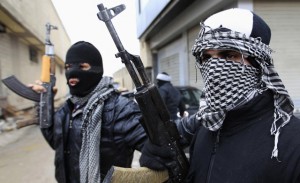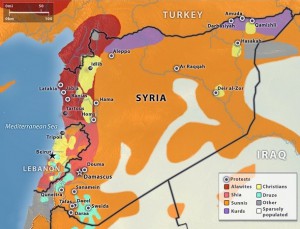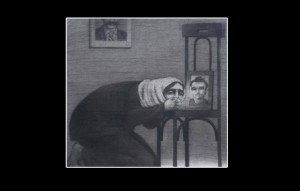The United States and its allies have been so eager to remove the Assad regime in Syria that they’ve enabled some extreme elements to move into the void. Could the Western strategy in Syria result in the displacement of a secular regime with elements of Al Qaeda?
“I saw the militants grabbing five villagers and threatening them and saying, “Either you convert to Islam, or you will be beheaded.’”
Christian villager in Maaloula, Syria
By: Joe Giambrone. Edited by Dave Lindorff.
The US decision to hold off on directly bombing Syria and to agree to Russia’s proposal to have Syria relinquish control of its chemical arms is just one part of a much larger story. And with the US government still treating Syria like a part of the “Axis of Evil” it was declared to be during the Bush/Cheney administration, it may not be the end of that story, either.
Rather, the Russian-originated proposal to have UN-authorized international authorities destroy the Syrian government’s stocks of chemical weapons may more properly be seen as just one more bump on the road toward achieving Washington’s long-held objective of establishing a more friendly government in Damascus. This raises a rather crucial question:
What is the true nature of the rebel forces that the US and its allies are backing in Syria with money, increasingly heavy arms, and threats of direct military support?
The Assad government stands accused by UN Secretary-General Ban Ki-moon of committing “crimes against humanity.” But what about the Syrian rebel forces?
John Kerry claims the rebel opposition has “increasingly become more defined by its moderation, more defined by the breadth of its membership, and more defined by its adherence to some, you know, democratic process…” But numerous experts say otherwise. A new study by defense consultant IHS Jane’s counts nearly half of the Syrian insurgent forces as hard-line Islamists. That’s an assessment that’s challenged in other quarters, but only in degree, with the Christian Science Monitor suggesting radical islamist groups may comprise only 10% of rebel fighting forces. But then, numbers aren’t the only measure of influence.
And as Reuters wrote:
“Secretary of State John Kerry’s public assertions that moderate Syrian opposition groups are growing in influence appear to be at odds with estimates by U.S. and European intelligence sources and nongovernmental experts, who say Islamic extremists remain by far the fiercest and best-organized rebel elements.”
What is known is that the Syrian rebel forces have been accused by the UN Human Rights Council in their report of June 4, 2013, as having committed “war crimes, including murder, sentencing and execution without due process, torture, hostage-taking and pillage.” They are also blamed for terror bombings with no clear military objectives, seemingly designed to frighten the population and with “sporadic shelling of pro-Government areas.”
Perhaps even more troubling is the rebels’ alleged use of sarin nerve gas — the very chemical weapon that President Obama cited in his failed bid to win public and Congressional support for a punitive US bombing blitz on Syrian government targets. One of the UN’s leading human rights investigators, Carla del Ponte, said, “I was a bit stupefied that the first indication we got, they were about the use of nerving gas by the opponents.” She added that there was “strong, concrete suspicion but not yet incontrovertible proof of the use of sarin gas, from the way the victims were treated.” The United Nations itself, heavily influenced by the US, was predictably more cautious and the UN’s Human Rights June report did not provide a definitive statement on the matter of guilt, either government forces or the opposition rebels.
The rebel group considered the most experienced, most effective, best supplied and best armed is the Jabhat Al Nusra. Composed primarily of veterans of the Iraq, Afghanistan, Libya and Chechnya conflicts who have flocked to Syria’s front lines, these fundamentalist jihadis have pledged allegiance to Al Qaeda. Estimates of their numbers range from 2,000 to 10,000.
After Al Nusra’s ties to Al Qaeda in Iraq became known, support for the group actually increased in terms of recruits and equipment, according to the UN report. Left unsaid in the UN report is the source of the arms and money going to these Al Qaeda groups. Turkey has hosted the opposition rebels on its soil for several years, while Qatar and Saudi Arabia, like Turkey closely linked to the US, joined in with massive infusions of cash in 2012.
The Saudi monarchy denies that it provides support for terrorism and pledges to uphold international standards and laws, but the historical evidence suggests otherwise. The 9/11 Commission Report, for example, which avoided directly blaming the Saudi state, did state that:
“’charities with significant Saudi government Sponsorship’ may have diverted funding to Al Qaeda. U.S. officials remain concerned that Saudis continue to fund Al Qaeda and other terrorist organizations.”
And CNN reported in May of 2011:
Then there are the Saudis, who funded al Qaeda from the beginning. WikiLeaks reported November 28 that a cable from the State Department in December 2009 complained that Saudi donors remain the primary financiers of Sunni militant groups like al Qaeda. The cable confirmed that very little has changed since former Undersecretary of the Treasury for Financial and Terrorism Intelligence Stuart Levey’s testimony before Congress in 2006. “On terrorist financing … there has been a real lag between what (the Saudis) say they were going to do and what they do,” he said.
It is also known that the Saudis’ point man, as in prior insurgencies in the Middle East, has been Prince Bandar bin Sultan, sometimes known as “Bandar Bush,” for his tight relationship with both George H.W. Bush and George W. Bush. Bandar has a reputation as a major Mideast player, a financier with deep pockets and a track record of sponsoring international insurgencies.
It was Bandar who, in coordination with the CIA, provided arms and money to Osama bin Laden, among others, for operations in Afghanistan during the resistance to the Soviet occupation of that country in the 1980s. It was also Bandar who helped move arms to the Contras in Central America, again with the CIA, in the Iran/Contra affair.Bandar bin Sultan was recently named, by Al Nusra fighters in the Ghouta area of Syria, as a supplier of sarin nerve gas. If true, these allegations make a mockery of the official US justification for attacking the Assad regime. A key argument of the Obama administration is that the regime—and the regime alone—has been responsible for chemical weapons attacks. A statement on the White House website, which clearly ignores the testimony of UN investigator del Ponte, claims: “We assess that the [Syrian] opposition has not used chemical weapons.”
Bandar bin Sultan is also alleged, astonishingly enough, to have recently threatened Russia (more or less overtly) with terrorism at the upcoming Olympics in Sochi. In an effort to strong-arm the Russians, Bandar, according to this account, traveled to Moscow to demand that President Putin abandon Assad in Syria. Oil incentives and arms sales were reportedly offered to Russia as an inducement to give up Syria. Bandar’s reported exchange with Putin is both chilling and damning. Sultan:
“As an example, I can give you a guarantee to protect the Winter Olympics in the city of Sochi on the Black Sea next year. The Chechen groups that threaten the security of the games are controlled by us, and they will not move in the Syrian territory’s direction without coordinating with us. These groups do not scare us. We use them in the face of the Syrian regime but they will have no role or influence in Syria’s political future.”
The UK-based Telegraph reported the conversation as well, and many now wonder if Bandar bin Sultan has outed himself as one of the leading terrorists in the world today.
Particularly striking is Russian President Vladimir Putin’s matter-of-fact response in this purported exchange:
“We know that you have supported the Chechen terrorist groups for a decade. And that support, which you have frankly talked about just now, is completely incompatible with the common objectives of fighting global terrorism that you mentioned. We are interested in developing friendly relations according to clear and strong principles.”
Whatever Bandar may have proposed has seemingly failed, since Russia has stood unflinchingly by Assad.
The Saudi-al-Qaeda-in-Iraq-Syria Axis
There are more rebel links to Al Qaeda in Syria too. Abu Bakr al-Baghdadi, the head of the Islamic State of Iraq, a second Qaeda-linked fighting group, announced a merger with the Syrian Al Nusra rebels. In April of 2013, Al Jazeera reported al-Baghdadi’s speech:
“It is time to announce to the Levantine people and the whole world that Jabhat al-Nusra is merely an extension and part of the Islamic State of Iraq.”
The merger was confirmed by an Al Nusra website.
The Islamic State of Iraq has repeatedly been linked to Saudi funding, often through charities and individuals. The Congressional Research Service notes:
“According to the U.S. State Department 2007 International Narcotics Control Strategy Report, “Saudi donors and unregulated charities have been a major source of financing to extremist and terrorist groups over the past 25 years.”
Al Qaeda Rises Again, in Syria
Oft-quoted terrorism expert Peter Bergen suggested that conditions in Syria are reviving the Al Qaeda jihad. “Al Qaeda’s future rises and falls in Syria to some extent . . . We can look around the world–there are actually a lot of places they’re not doing well. But clearly they’re doing very well in Syria.”
As with 9/11 and other recent events, this resurgence of Al Qaeda activity in the Syrian civil war could have long-term repercussions, including blow-back, as Putin has warned and as US experience in backing Afghanistan’s mujahadeen demonstrated. US and European citizens are traveling to Syria to fight in the jihad, and they could return to put their training and experience to use later in their home countries.
Like Afghanistan and Iraq before it, Syria should be seen now as a jihadist training ground, an engine of radicalization and a place to learn sabotage and other terrorism techniques.
The Big Picture
Clearly, US policymakers and military strategists know about the Al Qaeda links to rebel forces it is either directly or indirectly supporting in Syria’s civil war. So why is the US doing this, even to the point of seeking to bomb the Assad government? The best answer may be geopolitics and the politics of oil.
Because of its central location at the crossroads of Africa, Europe and the oil-rich Middle East, Syria, though not a big oil producer itself, has always held strategic significance. As early as 2005 the Bush administration was secretly jockeying for influence there, according to government documents released by WikiLeaks, via the Washington Post:
“State Department has funneled as much as $6 million to the [Syrian opposition] group since 2006 to operate the satellite channel and finance other [unspecified] activities inside Syria… The U.S. money for Syrian opposition figures began flowing under President George W. Bush after he effectively froze political ties with Damascus in 2005…”
Seymour Hersh reported in 2007 about a “Redirection” toward destabilizing Iraq’s neighbors, with a new focus on backing Sunni groups to counter the influence of Shi’ite Iran and Hezbollah. Bashar al Assad’s Alawite sect is also Shi’ite. Saudi Arabia, conversely, is a bastion of Sunni Islam.
Hersh’s New Yorker piece indicated that Bandar bin Sultan was already deeply involved as of March, 2007, and that the US regional strategy indicated:
“…the Saudi government, with Washington’s approval, would provide funds and logistical aid to weaken the government of President Bashir Assad [sic], of Syria.”
And then there’s this. Just two months after the September 11th 2001 attacks, General Wesley Clark, former commander of NATO forces and a one-time candidate for the Democratic presidential nomination, reports that he learned from an officer in the Joint Chiefs of Staff that the Bush White House planned to attack 7 countries, including Syria, over the following 5 years.
“We’re gonna start with Iraq, and then we’re gonna move on to Syria, Lebanon, Libya, Somalia, Sudan and Iran.”
General Clark has for years been vocally denouncing this “policy coup”. He said that in each case the publicly announced war pretexts were not important: this was grand-scale global strategy and nothing more. And on the evidence, it may still be a long-term US strategy.
Where this is Headed—Or Beheaded
The Alawites in Syria, who count the Assad clan among their number, make up only 12 percent of the country’s population, and as the ruling group are noted for having permitted an unusual religious and ethnic diversity. For this reason, Bashar al Assad, who like his father has run a secular (if authoritarian) government, has retained wide support within Syria for defending the state from outside religious extremists. Without such support by a sizable portion of the population, the regime could not have held out against the nearly 100,000 foreign-backed insurgents now reported operating inside Syria. As Reuters reported in May of 2011:
“Sunni Muslims form a majority in Syria, but under four decades of rule by Assad’s minority Alawites the country’s varied religious groups have enjoyed the right to practice their faith. Calls for Muslim prayers ring out alongside church bells in Damascus, where the apostle Paul started his ministry and Christians have worshipped for two millennia.”
Lately, al Nusra has sought to soften its public image by following Hezbollah’s lead in offering social assistance, but even the toned-down Al Nusra is not to be underestimated in its ultimate ambitions. Last April, an al-Nusra leader told CNN:
“In the period after the regime falls, our main goal is to create an Islamic state that is ruled by the Koran. It can have civilian institutions, but not democracy. We look at the other Free Syrian Army rebels as one of many groups defending religion, so we support them. In the future, we will handle this differently.” (emphasis added)
For a sampling of what Syrian Christians, Jews, Shi’ites and secularists can expect, we look to the case of the city of Homs, in March of 2012:
“Anti-government militants have expelled 90% of Christians in Homs and confiscated their residences by force, said Fides, citing a note sent to the agency by the Syrian Orthodox Church. The Vatican [news] agency cited sources saying militants went door to door in the Homs neighborhoods of Hamidiya and Bustan al-Diwan, “forcing Christians to flee, without giving them the chance to take their belongings.” –LA Times
The death toll in Syria’s civil war stands at 110,000 and rising — from all sides and from all kinds of weapons, not just chemical ones — and over 2 million refugees have now fled the country to camps in neighboring states. This state of affairs calls for a candid discussion of the motives of the various players. For starters, instead of pushing for a negotiated resolution of the Syrian conflict, why is the US sending more and heavier arms to rebels whose goals may be inimical to long-range US interests?
[box] WhoWhatWhy plans to continue doing this kind of groundbreaking original reporting. You can count on us. Can we count on you? What we do is only possible with your support.
Please click here to donate; it’s tax deductible. And it packs a punch.[/box]
GRAPHIC: http://images.alarabiya.net/46/6a/640x392_74238_201906.jpg
Syria Conflict : Syrian Civil War could spread neighbouring countries / Syria Conflict News
https://www.google.com/search?site=&tbm=isch&source=hp&biw=1600&bih=805&q=syrian+artists+painters&oq=syrian+art&gs_l=img.1.5.0l8j0i5l2.8276.12321.0.20237.10.10.0.0.0.0.175.999.6j4.10.0.ekfns%2Ckfns%3D800…0…1.1.27.img..0.10.994.TC3B35GHlpY#facrc=_&imgdii=_&imgrc=IBiHLmiAWU6X-M%3A%3Bt5Nyir4a7o6UjM%3Bhttp%253A%252F%252Fenglish.al-akhbar.com%252Fsites%252Fdefault%252Ffiles%252Fimagecache%252F5cols%252Fleading_images%252Fabdelki2.jpg%3Bhttp%253A%252F%252Fenglish.al-akhbar.com%252Fnode%252F16479






